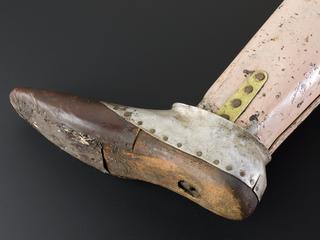








Combined knife and fork, made of silver-plate, designed for the use by a one-armed man to a design known as the Nelson pattern, after Horatio Nelson (1758-1805), from the Royal United Service Institution, England, and dating from the First World War, 1914-1918.
Eating a meal using only one hand can be difficult. The design of this combined knife and fork is known as a Nelson pattern, named after Horatio Nelson (1758-1805), the British naval hero who lost an arm during the Battle of the Nile in 1798. He was presented with a similar piece of cutlery, made from gold.
This silver plated knife dates from the First World War. Many of the thousands of arm amputees from that conflict were issued with these implements as part of their rehabilitation. A simple but highly effective design, similar designs are still available today.
This example was previously owned by the Royal United Services Institute. They were established in 1831 and continue to research and study every aspect of national defence and security, including military tactics and terrorism.
Details
- Category:
- Orthopaedics
- Collection:
- Sir Henry Wellcome's Museum Collection
- Object Number:
- A635095
- Materials:
- iron, silver (metal) and complete
- Measurements:
-
overall: 19 mm x 200 mm x 34 mm, 0.07kg
- type:
- combined knife and fork




